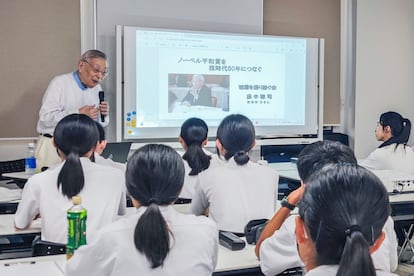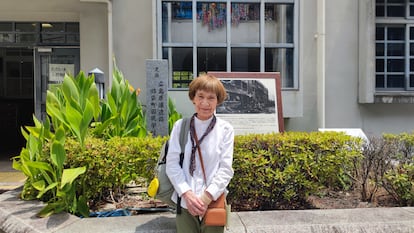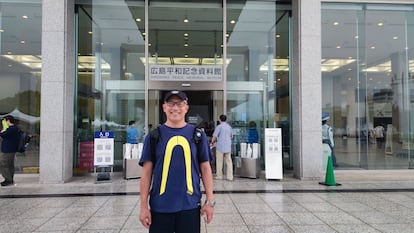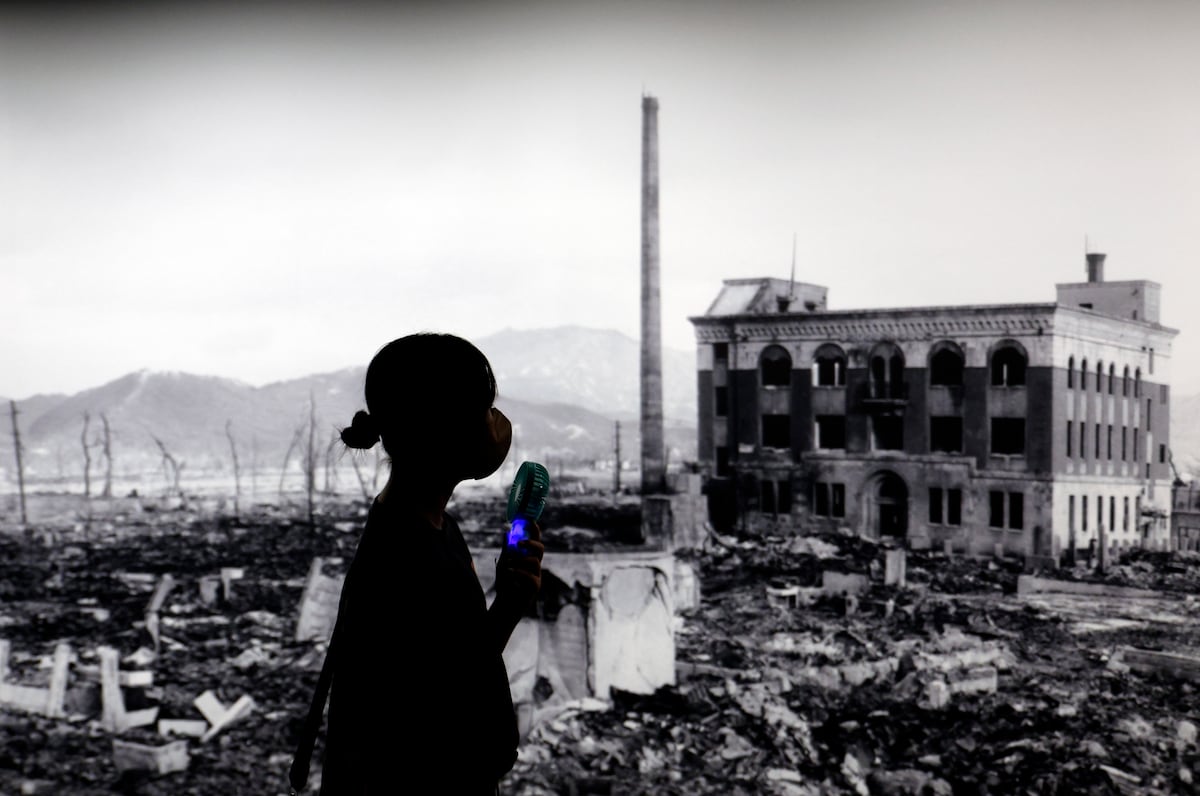The clock reads just after 9 a.m. Thermometers are already above 30ºC (86ºF). Bicycles, buses, and cars crisscross the leafy boulevard. A mother and daughter bow in reverence at the entrance to a shrine; suited officials walk briskly; uniformed schoolchildren listen to their teachers’ explanations; tourists follow their guide’s pennant toward the river. It is an August morning in Hiroshima, 80 years after the Enola Gay, an American B-29, dropped the most destructive weapon ever used in war on the population of this Japanese city: the atomic bomb.
“So many died without being able to tell their story… That’s why we’re speaking out, so that it won’t be forgotten,” says Satoshi Tanaka, a survivor of the August 1945 disaster and a member of Nihon Hidankyo, the institution awarded the Nobel Peace Prize in 2024, “for its efforts to achieve a world free of nuclear weapons and for demonstrating with witness testimony that nuclear weapons must never be used again,” according to the Nobel Committee.
Hiroshima has been rebuilt stone by stone, but the still visible scars of that attack are a stark reminder that the world cannot afford to repeat the hell experienced here, which Nagasaki would also be subjected to three days later. However, in a context marked by growing distrust between world powers, that lesson seems to be in danger of being forgotten.
Eight decades after the end of World War II and the subsequent construction of a new rules-based global order, international consensus on non-proliferation is weakening. Moreover, the nine nuclear-weapon states (the United States, Russia, the United Kingdom, France, China, India, Pakistan, North Korea, and Israel) have ambitious plans to renew their arsenals and delivery systems, according to the 2025 report of the Stockholm International Peace Research Institute (SIPRI).
The language of deterrence has returned to the forefront of geopolitical discourse, and with it, the possibility that nuclear weapons could once again emerge as a real option in conflict scenarios.
 Atomic bomb survivor Satoshi Tanaka gives a talk to high school students.
Atomic bomb survivor Satoshi Tanaka gives a talk to high school students.
Tanaka was one year and four months old when, on the morning of August 6, 1945, a white flash cut across the sky above Hiroshima. Little Boy, a bomb measuring three meters in length, weighing four tons, and carrying about 50 kilograms of enriched uranium, had just exploded 580 meters above downtown. It was 8:15 a.m. on a Monday, and the city was already in full swing.
4,000ºC and 140,000 dead
In a matter of seconds, the explosion unleashed an unprecedented amount of energy over an inhabited area. Beneath a giant mushroom cloud, the air was transformed into fire; it is estimated that at the epicenter of the impact, the heat reached 4,000ºC at ground level; 70,000 people were killed instantly. Another 70,000 would die before the end of the year, either from their injuries or from radiation exposure.
The blast wave devastated the heart of the city, leaving behind a landscape of rubble, ash, and desperate pleas for help. From a bustling metropolis of 300,000 inhabitants, Hiroshima was transformed into a wasteland of devastation and horror in a matter of minutes. Thousands of wounded cried out for help, their bodies covered in burns, their skin peeling off, and their clothing reduced to rags. Some walked in silence, others lay on the ground as the fires raged through the remains of the city. Of 90,000 buildings, 60,000 were destroyed, and 6,000 more were damaged beyond repair.
Three days later, on August 9 at 11:02 a.m., another American bomber, Bockscar, dropped an atomic bomb (this time a much more powerful plutonium bomb) on a suburb of Nagasaki. Fat Man killed 40,000 people that day and was responsible for the deaths of another 30,000 by the end of 1945. Japan capitulated a week later, on August 15, and officially surrendered on September 2, effectively ending the Second World War.
The testimonies
Tanaka, now 81, lost almost his entire family as a result of the bombing. He keeps his mother’s diaries, in which she described what postwar Hiroshima was like. “Barbarism is a fact. That’s why I try to pass my baton on to the younger generations, to make sure they know what happened,” he told EL PAÍS minutes before beginning a talk for high school students.
The testimonies of those who experienced the tragedies of Hiroshima and Nagasaki firsthand — the so-called hibakusha — are harrowing. And they are becoming fewer and fewer. The inexorable passage of time means that voices capable of recalling the horror are disappearing. According to official figures, in March 2025 there were 99,130 hibakusha across Japan, with an average age of 86.13 years.
At the Hiroshima Peace Memorial Museum, photographs from the days following the catastrophe, victims’ belongings, remains of the city, and various artifacts related to the atomic bomb on display highlight the magnitude of the disaster and confront visitors with the brutal reality of the use of nuclear weapons.
“I remember a childhood surrounded by ruins and chaos,” recalls Sumiko Fujii, 74. Her mother and aunt were hibakusha, who grew old without knowing the whereabouts of a third sister. Fujii says she had been aware that something serious had happened to her family since she was three, even though her mother avoided talking about the bomb. “My mother was unharmed, but my aunt’s arm was covered in keloid scars,” she recalls.
 Sumiko Fujii, daughter of a ‘hibakusha’ and pacifist activist.Inma Bonet
Sumiko Fujii, daughter of a ‘hibakusha’ and pacifist activist.Inma Bonet
Many hibakusha developed leukemia, various types of cancer, and other illnesses that reflected the invisible damage of the bomb. These physical scars were compounded by social stigma, workplace discrimination, and the persistent fear that their children would be born with genetic defects.
Growing nationalism
Fujii is a petite woman with a sweet and curious gaze. She says she grew up trapped in a contradiction: “Japan was a victim of the atomic bomb, but before that, it was a predator.” For this reason, she decided to dedicate her life to anti-war and anti-nuclear activism. In 1992, she founded the Article 9 Society Hiroshima, which defends and promotes the pacifist spirit enshrined in this article of the Japanese Constitution. Fujii is concerned about the growing inclination toward nationalist positions among young Japanese people — as demonstrated by the results of the last election, in which a far-right party surprisingly performed well — and that “more and more people are in favor of rearmament.”
Even so, the atmosphere in Hiroshima during these days of commemoration is one of conciliation. Around Peace Park, the epicenter of collective memory, messages rejecting war abound. Thousands of orizuru, colorful paper cranes, hang in display cases or from trees; dozens of students leave handwritten messages; volunteers pass on the city’s symbolic value to future generations.
Concerts, recitals, marches, and rallies have been organized. One of them, over the weekend, called for an end to the genocide in Palestine. “It’s terrifying. We haven’t learned anything in 80 years,” laments hibakusha Masako Kido. She was two years old when the atomic bomb fell, but her family lived far enough from ground zero for everyone to survive. A former music teacher, she devoted herself to studying languages in her youth and traveling the world after retirement. Now she says she’s afraid of the future: “What’s happening is very dangerous. I see a very bleak future, because of politicians like [Benjamin] Netanyahu, [Donald] Trump, or [Vladimir] Putin.”
 Tetsuo Hamano, grandson and son of ‘hibakusha.’Inma Bonet
Tetsuo Hamano, grandson and son of ‘hibakusha.’Inma Bonet
It’s an opinion shared by survivor Tanaka: “The risk is that many leaders now have the option of pressing the [nuclear] button.” “Talking about deterrence is nonsense, a lie,” he emphasizes. “Nuclear countries don’t rule out using such weapons in the event of war. It’s dictatorial and intimidating behavior.” He acknowledges his fear that the memories of Hiroshima and Nagasaki will be diluted by the passing of the hibakusha.
Tetsuo “Pancho” Hamano, the 55-year-old grandson, son, and nephew of a hibakusha, is more optimistic. “Anyone who visits Hiroshima clearly understands what is at stake if that line is crossed,” he says. Hamano is a law graduate who, after decades dedicated to the business world in larger cities like Tokyo and Osaka, decided to return to his native Hiroshima a couple of years ago. “My father and grandfather were passionate about peace education, and they repeated their experiences to me over and over again,” he says. During the pandemic, he turned his life upside down and now works as a guide, the “destiny” his father prepared him for, he jokes.
Hamano, like so many other voices in Hiroshima, asks the world not to repeat the mistake made in 1945. He insists that history “cannot be changed” but neither “can it be ignored,” and that, therefore, in turbulent times like these, it is crucial to “understand the past in order to move toward the future in the right direction.”
Sign up for our weekly newsletter to get more English-language news coverage from EL PAÍS USA Edition
